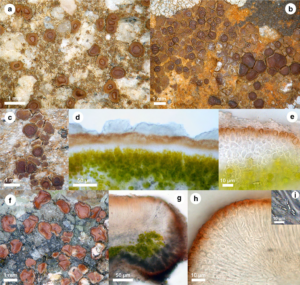Acarospora septentrionalis M. Westb. & Wedin, in Ariyawansa et al., Fungal Diversity 75: 129 (2015)
Index Fungorum Number: IF 813043; MycoBank number: MB 813043; Facesoffungi number: FoF00927
Etymology – In reference to the northern distribution of the species.
Holotype – NORWAY, Sogn og Fjordane, Årdal, along Tindeveien between Øvre Årdal and Turtagrø, UTM (WGS84) 32V 0431788 6807104, alt. 984 m, on cement, 12 June 2008, Martin Westberg 08-148 (S F132535).
Synonym– Acarospora badiofusca v. glaucocarpoides H. Magn., Göteborgs Kungl. Vetensk. Samhälles handl., ser. 4, 28: 117 (1924). Type: Sweden. Torne Lappmark, Jukkasjärvi par., prope Torne träsk, Jebrinjokk, 600 m. 16 July 1919, Magnusson 3310 (UPS L-522388, lectotype, here designated).
Lichenized, photobiont a chlorococcoid alga. Thallus epilithic, areolate to rarely subsquamulose; areoles rounded at first, becoming irregular in outline, to 0.55 mm thick, 0.3–0.8(−1.5) mm across, the largest becoming subsquamulose with edges raised from the substrate; upper surface pale brown to medium brown, smooth, mat, epruinose, but sometimes with large, pruina-like flakes formed by detaching epinecral layer; epinecral layer present, colourless, 0–40 μm thick; cortex, paraplectenchymatous, 25–60 μm thick, uppermost cell-layer reddish brown, below colourless, cells distinct, rounded to elongated or somewhat irregular, lumina up to 7 μm across; algal layer continuous; medulla white, hyphae with rounded to elongated, thin-walled cells, lower cortex lacking. Apothecia lecanoroid, at first immersed with a sunken disc, soon expanding and becoming raised and often darker brown than the thallus (in a similar way to A. badiofusca); disc, brown, at first concolourous with the thallus, later often becoming darker brown, plane, round, epruinose, 0.3– 1 mm diam.; true exciple at first invisible from the outside, becoming distinct in later stages and then concolourous with t h e di s c , I – , insection prosoplectenchymatous, below the hymenium composed of elongated, narrow, rather indistinct cells forming a very compact layer, to c. 25 μm thick, towards the surface expanding, becoming fan-shaped and composed of small, rounded to somewhat elongated cells, the uppermost cells rounded, 2–4 μm wide, laterally merging with the cortex; epithecium, medium brown–reddish brown; hymenium colourless, I+ blue, 65–90 μm tall; paraphyses, easily distinguished in water, 1.5–2 μm wide in mid hymenium,
tips cylindrical to weakly clavate, rarely up to 5 μm wide; subhymenial layers colourless, wedge-shaped, up to 80 μm tall centrally, composed of small, more or less rounded cells; with numerous, colourless oil-drops. Asci 70–80×15–18 μm (few well-developed seen), narrowly clavate, >100-spored. Ascospores colourless, simple, narrowly ellipsoid–ellipsoid, 3–5×1.5–2 μm. Pycnidia rare; conidia ellipsoid–ovoid, 2–2.5×1.5 μm. All spot tests negative.
Material examined– ICELAND, Nordur-Island, East side of Eyjafjörður, on ledge above a brook, 10 June 2007, L. Fröberg (LD); NORWAY, Finnmark: Varanger Peninsula, Vardø, Bukkemoltangen, 1 July 2014, M. Westberg VAR043 (S F263442); Varanger Peninsula, Båtsfjord, Skogdalen, 2 July 2014, M. Westberg VAR048 (S F263443); SWEDEN, Lule Lappmark, Jokkmokk par., Padjelanta National Park, north side of lake Virihaure (Virihávrre), at the foot of Mt
Allak, c. 3.5 km SSWof the peak Allaktjåhkkå and c. 10 km N of Staloluokta, 590 m alt., 31 July 2004, M.Westberg 3064 (LD); Torne Lappmark: Jukkasjärvi par., Jebrinjokk, 400 m, 16 July 1919, Magnusson 3310 (UPS L-514336); near Torneträsk, Nuolja. 2 August 1921, Magnusson 6199a (UPS L-514869).
Ecology and distribution: Acarospora septentrionalis is currently known from the montane regions of northern Scandinavian and from Iceland. It has been collected on calcareous schist, dolomite and cement.
Notes – Magnusson (1924) first described this taxon as a variety of A. badiofusca (var. glaucocarpoides), but later changed his mind and considered it to be a peculiar form of A. glaucocarpa (Magnusson 1929).We find that this is a morphologically distinct taxon and molecular data support the distinction of A. septentrionalis as a species. The epithet glaucocarpoides is not appropriate to use due to the already existing name Sarcogyne glaucocarpoides Flagey (1896) and hence we describe it as a new species here. It is somewhat similar to A. badiofusca, especially when the apothecia becomes superficial and darker than the surrounding thallus. Acarospora badiofusca, however, usually has larger and more distinctly sessile apothecia, which typically become dark brown to almost black. The paraphyses in A. badiofusca are wider (2–3 μm) and the spores are also wider (2–3 μm). The molecular data clearly show that A. septentrionalis is not conspecific with A. badiofusca or its close relative A. cervina. Acarospora septentrionalis may also be confused with A. glaucocarpa. However, A. septentrionalis (like A. badiofusca), has an algal layer that is continuous and not interrupted by hyphal bundles as in A. glaucocarpa and some other species (Knudsen et al. 2014). A further difference to A. glaucocarpa is the paraplectenchymatous cortex consisting of rounded, thin-walled cells. Acarospora glaucocarpa on the other hand has a prosoplectenchymatous cortex of irregular hyphae with narrow lumina.

Fig. 1 a–e Acarospora septentrionalis a Norway, Westberg 08-148 (Sholotype) b Iceland, Fröberg (LD) c Sweden, Westberg 3064 (LD) d, e(holotype) Section through thallus showing continuous algal layer, a paraplectenchymatous cortex and thick, uneven epinecral layer
